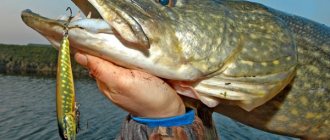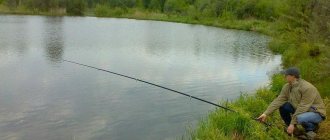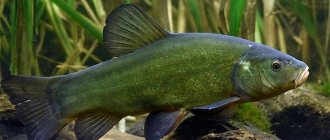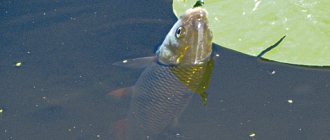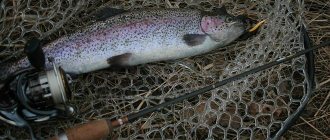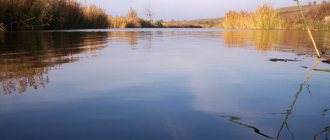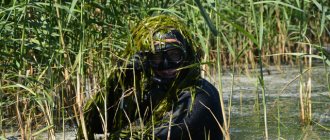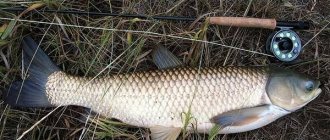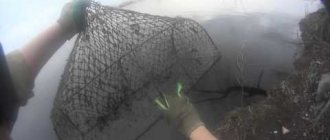Fishing in fog and thunderstorm
All authors of fishing literature known to me mention only three atmospheric phenomena in their works and evaluate changes in biting activity during these phenomena. This is haze, fog and thunderstorm. Here is what Sabaneev writes about this: “The best bite happens on a clear, quiet, somewhat cool morning with a little fog.” A. M. Pieper believes that clear, no wind, weather is not very favorable. V. Andreev cites the opinion of one of the participants in the last catfish fishing competition, M. Dokukin, who believes that cloudy weather with haze and a medium wind are better for catching catfish in the spring. M. Matveev shares the same opinion. According to his observations, warm, quiet, cloudy days (especially in spring and autumn), when the horizon is covered with a light haze, are most favorable for fishing. Other authors also share this opinion. A little further on, Matveev says that morning fogs in spring and summer improve the bite. Although, I think that fogs themselves cannot improve the bite. If you ask the question “why?”, then meteorologists will have only one answer - both haze and fog in the described weather conditions indicate the observed stable weather, and it, as everyone notes, is the first necessary factor for active biting. True, not all types of fogs are indicators of good, stable weather: there are frontal fogs, caused by clouds descending to the ground.
Another atmospheric phenomenon, a thunderstorm, also appears quite often in descriptions of observations of weather conditions favorable and unfavorable for fishing. If you look into the fishing literature, you can come across a mention of this phenomenon by L.P. Sabaneev. Speaking about the intensity of the carp's bite, he writes: "... In general, before every sudden change in weather, the bite weakens or completely stops: however, it is known that carp take very well during a thunderstorm." Already today M.M. Matveev in the book “Companion to the Angler-Sportsman” in the section “The influence of weather on the fish bite” writes: “Before an approaching thunderstorm, an intense and very short-term bite occurs. You can’t catch fish during a thunderstorm.” In the fishing literature of different years, from time to time there is a description of fishing during an approaching thunderstorm. And, as a rule, all anglers have a description that is either identical or very similar. M. Pieper writes that a thunderstorm acts in different ways: a deterioration in the bite of some fish, which occurs long before a thunderstorm, indicates its approach. M. Matveev, on the contrary, Fr. In another, later article, Matveev writes that short-term warm thunderstorm-type rains contribute to fishing success.
According to his observations, before a thunderstorm and during rain, when there is no wind, the pike's appetite increases, and chub and carp are caught well. During a thunderstorm, the bite temporarily stops. In the summer after rain, if the weather has not changed dramatically, all fish bite especially well. But A. Ya. Yakovleva and co-authors write that before the onset of a thunderstorm and during its passage, the bite noticeably worsens. But on the other hand, as soon as the thunderstorm stops and the rain stops, the bite resumes again, and with increased activity.
However, there are a number of authors who have written about active biting during a thunderstorm. Moreover, in their opinion, the thunderstorm “allowed” them to catch large specimens of fish, whereas before the thunderstorm only small fish were biting. Thus, V. Kazantsev in the article “Roach” asks the following question: “How, for example, can we explain the reckless biting of roaches before a thunderstorm?” Answering his own question, he suggests that the activity of some animal organisms under the influence of a thunderstorm causes a short-term hunger in the roach. I. Kazakov writes (I quote): “In roach fishing there is another amazing moment that rarely falls to the lot of the fisherman, but which every angler should under no circumstances forget about. This moment occurs about an hour before the onset of heavy rain, accompanied by a powerful “salute” of thundering lightning. Before such a tropical downpour, capable of causing a “global flood” in half an hour, the roach takes any bait for twenty to thirty minutes with such amazing greed that it seems like it has been overcome by insanity. This phenomenal bite stops as suddenly as it began, almost instantly. You are not even able to immediately understand what happened. Why did the floats suddenly stop? And this means that in fifteen to twenty minutes such a “shower” will fall on your head that you need to take better cover before it’s too late.” A. Krom, just like the two previous authors, noted that on the Oka (in its treasured place) catfish up to a kilogram in weight were caught only in a thunderstorm. “The louder the thunder rumbled, the wind raged and the rain poured down, the better they got.”
This happened for more than one year, and in good weather, both in the morning and in the evening, nothing worthwhile (at this place) worked out. V. Nazarov, in the article “Fishing and Thunderstorms,” emphasized that he repeatedly had to catch large, cautious fish during strong thunderstorms, and the bite was usually violent, although short-lived. Nazarov mentioned that many of his fishermen friends told him about cases of catching large fish during a thunderstorm. Nazarov believes that “such a fish bite is associated with the increasing electrification of water during a thunderstorm, which, apparently, serves as a “stimulator” of the bite.” The different opinions of the authors are quite understandable if you pay attention to the weather conditions accompanying the described thunderstorm. The explanation, as they say, lies on the surface. All authors observed a thunderstorm and assessed the biting activity of different fish before, during and after the passage of a thunderstorm. But Pieper and Yakovlev observed and describe thunderstorms associated with a front, and Matveev means a thunderstorm of an intramass nature. The difference in weather conditions between frontal and intramass thunderstorms is very large. In a nutshell, frontal thunderstorms are associated with inclement weather during the passage of cyclones with active fronts. At the same time, a rapid and sharp change in all meteorological elements occurs above the observation point due to a relatively rapid change in the outgoing and incoming air mass. Intramass thunderstorms are an atmospheric phenomenon that occurs due to daytime heating under otherwise favorable conditions in the same air mass. The passage of such a thunderstorm does not lead to a significant change in the properties of the air mass located above the fishing spot. Air temperature, pressure, wind and other meteorological elements remain approximately the same after the passage of a thunderstorm; they change only when the thunderstorm passes over the observation point.
I offer my impressions of fishing during the passage of an intramass thunderstorm. Afternoon. On the bank of the oxbow river Tsna I fish with two fishing rods. The bait on one is a traditional worm, on the other - porridge. It is aimed at any fish, as long as it bites and is caught. The weather is excellent, sunshine, cumulus clouds of good weather, although the number of clouds and their power are increasing. In the morning they were just “pieces of heavenly cotton wool,” but now their harmlessness has disappeared. The wind is still weak, about 3-5 m/s. In other words, the weather is a blessing. If I don’t catch something, at least I’ll have some fun fishing. The bite is “neither shaky nor weak.” It bites sometimes, but I can’t hook it, apparently it’s small fry. There is only one “sailor” and a frail roach in the cage. At about 16:00 I notice that on the horizon the cumulus clouds have grown to powerful, their tops are already swirling. After a while, there was a flash in the distance and thunder was heard, still weak and seemingly uncertain. There is already a thunderstorm, but it is distant (after a flash of lightning, thunder “reaches” me in more than 10 seconds). On the water everything remains unchanged. The storm is approaching. A tower of black cumulonimbus cloud has already covered half of the horizon, streaks of falling rain are already visible. Lightning flashes more often, thunder is heard almost immediately. The storm is near. I gather my things and prepare to retreat to the tent. The float of one fishing rod goes down sharply. I'm hooking. Bah, this is a decent crucian carp! I’ve never caught crucian carp in this oxbow before. While I was taking it off and looking at it, the float of the second fishing rod disappeared and... I had to remove one fishing rod, since the hook of the second fishing rod did not have time to lower before the bite followed. This went on for about 20 minutes. But then the cloud moved completely closer, thunder was already thundering almost overhead. The wind rustled, its gusts bent the bushes, the tent fluttered and began to breathe. The first drops of rain fell, and the bite immediately stopped; in such cases, fishermen say “it was cut off.” After waiting out the rain in the tent, I returned to the fishing rod again, expecting a bite, but the bait on the hook was not touched. Then not only the hunger, but also the simple bite was no more, although I waited for it for about two more hours. Approximately the same picture was in other cases. Moreover, zhor was observed both when catching peaceful fish and when catching predators with a spinning rod.
It has already been mentioned that all authors unanimously note a significant weakening of the bite when bad weather approaches. associated with a cyclone and a frontal thunderstorm... Perhaps Anatoly Onegov described this most artistically in the story “Traces on the Water.” For two years he observed the behavior of roach (sorog) and pike in the lakes of the Arkhangelsk taiga. During this time, he studied in detail the “schedule” of the behavior of sorogs and pike hunting. Here are short excerpts from this interesting story. “Nature periodically pays pikes, all pikes at once, with a luxurious table. And then the “echelons” (of pike) mix for a while, all the pike burst out of the depths at once and take part in the feast... A thunderstorm, a heavy, long thunderstorm is approaching, a long period of hunger, and then just before the thunderstorm, frightened flocks of pikes rush across the lake, having lost all caution — and the roar of pike bodies precedes the first rumbles of thunder on the taiga lake...”
In the article “Follow the Barometer,” Mosiash spoke about many years of scientific research into the problems of recreational fishing, carried out in the Upper Volga branch of GosNIORH (Konakovo). Here is a brief summary of the conclusions the staff of this research institute came to. I quote. “In summer, as in winter, pressure fluctuations were accompanied by low fishing intensity values for all fish without exception. The intensity of fishing was quite high at “even” pressure, when its changes did not exceed 2 hPa. As for the directional change in pressure, here the increase in pressure was characterized by the highest, and the decrease by relatively low fishing intensity. However, in this case, the ruff was an exception.” We can cite another 20-30 names of authors who analyzed the connection between biting activity and weather changes and observed a similar picture.
So, the first conclusion. All the authors, or the vast majority of them, noticed that the fish sense the approach of bad weather and within a day or two the biting stops. What is this “approximation” expressed in? Bad weather is usually associated with a cyclone. I will draw a certain “average” picture: the approach of a cyclone (or its trough), first of all, about a day or two before the start of rains, is associated with a noticeable drop in atmospheric pressure. According to the observations of Mosiasch and other authors, changes exceeding 2 hPa usually have a noticeable effect. But none of the authors mentioned that. and what was the intensity of the bite before the onset of this decrease in pressure and how did the intensity of the bite change 3-2-1 days before it completely stopped. This is important, but we can only speculate about it. Further, in the following days. 1-2 days after the start of a noticeable drop in pressure, an increase, thickening and lowering of clouds is observed. At the beginning, the upper tier clouds appear - cirrus, then the middle tier clouds float in and, finally, low clouds arrive. Precipitation begins and continues intermittently until the central part of the cyclone passes and pressure begins to increase in the rear of the cyclone, but on these days isolated rainfall may still be observed. While the front and central parts of the cyclone are passing, as a rule, there is continuous precipitation and at this time there is no bite or there is it in between rains.
So, observations by fishermen and studies conducted in the summer by employees of GosNIORH showed that the increase in pressure “was characterized by the highest fishing intensity.”
Conclusion two. Observations by Anatoly Onegov confirmed the conclusions made by other authors, including studies at GosNIORKH, and showed that with an “even” course of pressure, the “schedule” for the movement and feeding of schools of sorogs, as well as pike hunting for them, does not change from day to day . True, after “having eaten”, after 2-3 days the pike became somewhat “lethargic”. During periods of bad weather, fish feed only in “windows” between rains (Sabaneev, Matveev, Onegov, etc.). Feeling the approach of bad weather, and with it the days of forced fasting, all the fish break their usual “daily routine” and begin to actively feed. But this period of active feeding is extended over a day or two (or more), depending on the speed of movement of the cyclone, on the intensity of the cyclone and on which sector of the cyclone the body of water where observations are being made (fishing) falls.
Now it’s time to look at the drawing from the book “Meteorological Dictionary” by S. P. Khromov and L. I. Mamontova. The figure shows a record of the course of atmospheric pressure (above) on the barogram during the passage of a squall associated with a cumulonimbus cloud, thunderstorm and shower. Below is a record of the air temperature at the same time. The barogram shows that at the beginning of the process, when the cloud is still far away and only “grows” to the stage of cumulonimbus, thunderstorm, and this can last an hour or two, depending on many conditions. At this time, the pressure at the fishing point, where the cloud is moving, drops slightly. But the drop is most often small, somewhere within 2 hPa. and the inhabitants of the reservoir react to it quite calmly, as studies by GosNIORH have shown. Perhaps only inhabitants who are very sensitive to weather changes can react restlessly. When the cloud has reached the cumulonimbus stage, and the fisherman can record this by hearing a distant thunderstorm, the atmospheric pressure begins to increase (the growth is constantly accelerating), and all the inhabitants of the reservoir “begin to worry.” The cloud is growing and getting closer. The fisherman can already visually determine that the cloud is moving in his direction. The lower part of the cloud becomes leaden black, and the blinding white top ends with a veil of dense cirrostratus clouds, already covering half (or more than half) of the sky. Often already at this time you can see below, in front of the clouds, a swirling shaft of low ragged clouds; in meteorology it is called a “squall collar”. The cloud is approaching. The storm is getting close. At this time, the barograph pen draws a curve of sharply increasing pressure. In just 15-20 minutes the pressure “jumps” by 5 hPa (sometimes more or less). This moment corresponds to what Onegov so figuratively described, when the pike and pike, in a panic before such quickly approaching bad weather, promising a long hunger strike, sweep away all the “feeding schedules” and the bite turns into gluttons. The cloud is almost “over your head”, the “voice” of thunder almost merges with the sparkle of lightning, and the bite follows one after another. Finally, a thunderstorm is overhead, the barograph records the peak of pressure growth, and then “a squall bends the bushes to the ground, the tent breaks into “free flight,” the stakes can barely hold it.” The first drops of rain fall and after a few seconds the surface of the reservoir “boils” from large drops of rain. It’s raining “as if in buckets”, the bite, according to the fishermen, is “like crazy”. And the barogram registers a decrease as sharp as the increase in pressure when a thunderstorm approaches. Remember the findings of GosNIORH - when the pressure drops, the bite is bad or stops. Thermograph recording shows that the temperature curve has also gone down. After some time, the atmospheric pressure stabilizes at the same level or slightly higher, and after some time the biting resumes, but not as intensely as it was before. The entire phenomenon, as a rule, takes no more than 30 minutes, and a “witness” of the past atmospheric phenomenon remains on the barogram - the peak of the curve, which in meteorology is called the “storm nose”.
Such a surge in atmospheric pressure is common during the passage of a thundercloud, but a thunderstorm can be either frontal or intramass (either-or), and therefore the amplitude of the surge can be different, i.e. pressure can “jump” both by 5 hPa and by 1 hPa. The intensity of the increase and decrease in pressure depends on the nature of the process: the cloud can be 5-6 km thick, or its peak can reach the tropopause (10-11 km in summer), the power of the thunderstorm, the presence of a squall and the length of the peak of the pressure curve (thunderstorm nose) will depend on this. . The speed of the currents at altitude can be different, which means that the speed of the cloud’s movement will also be different, and with it the duration of such an intense bite. According to the observations of fishermen and my observations (I am also a fisherman), such a meal most often lasts from 10-15 to 20-30 minutes. It is characterized by a sharp beginning and an equally sharp ending of the bite. This phenomenon is especially pronounced when such a thundercloud is part of a “chain” of thunderclouds. In meteorology, as I already mentioned, such “chains” are called cold (or warm) atmospheric fronts. But the described phenomenon can also be observed locally during the passage of one powerful cloud in the absence of atmospheric fronts. This is possible under favorable atmospheric conditions.
The curve shown in the figure describes, of course, the “classical” pressure course. Judging by this curve, the upward surge was only about 5 millibars, but this is enough to “shift” the pike schedule.
A. Mailkov, analyzing the effect of changes in atmospheric pressure on the behavior of fish, draws readers' attention to the fact that a fish rising from a depth of 10 meters to the surface has to experience such a pressure difference as if a person quickly rose from the surface of the earth to a height of 12 kilometers. He believes that anyone who undertakes to analyze this phenomenon must understand that Nature has designed the fish in such a way that even sudden surges in pressure cannot have a noticeable physiological effect on its body. I can add. They can’t, but they do. “A natural conclusion suggests itself,” Mailkov continues, “the positive or negative impact of atmospheric pressure fluctuations on the behavior of aquatic organisms is determined by some other mechanisms, possibly related to the metabolic process.” These “other mechanisms,” in my opinion, may include infrasonic vibrations. In cumulonimbus clouds there is an intense process of condensation of water vapor, which, according to the research of S. N. Netreba and a number of other authors, leads to the generation of infrasound. In addition, a powerful cumulus and cumulonimbus cloud carries a significant electrical charge, which, when passing, changes the field strength above the reservoir and positively or negatively affects the electrical charges of the inhabitants of the reservoir, including by saturating the reservoir with negatively charged raindrops. S. Olegov explains: “The fact is that many inhabitants of the Earth have incredible sensitivity to the electric fields surrounding them. So, let's say, some fish manage to react to a field with a strength of 1/100 μV/cm. To give you an idea of how little this is, imagine that the contacts of an ordinary flashlight battery are applied one to the Anatolian coast, the other to the Crimean coast, and are closed across the Black Sea.” And it is possible that we are talking about both the electrical potential of a school of fish and the electrical potential of one fish. I have not yet come across a message in the literature about the possible value of the electrical potential in a school of fish. But in a flock of birds, according to Olegov, “experiments and computer calculations have shown that a flock of birds flying at an altitude of about 40 meters is under an electrical potential of about 6000 volts.” Can we assume that the changes in atmospheric pressure induced by a thundercloud, the generation of infrasound and the restructuring of the electric field are responsible for the nature of changes in fish biting activity? I think it is possible, but, agreeing with Mailkov, I believe that other mechanisms are also “to blame” for this, for example, those associated with squalls. Doctor of Physical and Mathematical Sciences L. Kh. Ingel and Candidate of Physical and Mathematical Sciences V. D. Feofilov discovered that squalls accompanying very powerful cumulonimbus clouds lead to soil vibrations in the vertical and horizontal plane. Their research showed that at a distance of 15-20 km, the seismograph quite clearly records ground vibrations caused by squalls. Conditions are created that are similar in their impact to earthquakes. Perhaps, such an impact can be called a “micro-earthquake”, in contrast to a “real” earthquake, the impact of which, even at a distance of many hundreds of kilometers, results in a complete lack of bite.
Conclusion three . During a thunderstorm, especially just before the start of a downpour, the bite can be very active, but not long-lasting and, as a rule, it ends with the start of a downpour.
Concluding this section, I have only one thing left to say: “Well, perhaps A. Mailkov is right.” Agreeing with Mailkov, I believe that other mechanisms are also “to blame” for this. pike schedule.
What time is it better to catch pike: morning, afternoon, evening or night, why it doesn’t bite, signs
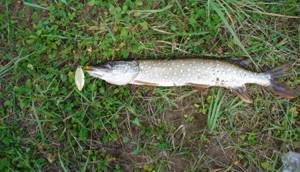
In the general chorus of opinions about what time pike is caught best, it is possible, despite disagreements, to find patterns that help determine this issue. The existing contradictions are caused by the personal experience of each individual fisherman and are explained by the characteristics of individual fishing. The basis for drawing up a daily and seasonal schedule remains knowledge and understanding of the natural features, feeding habits and behavioral norms of river predators.
Since pike is always in search of food, it can be caught all year round. Another thing is that in certain periods the catch will not be as significant as, for example, before or after spawning.
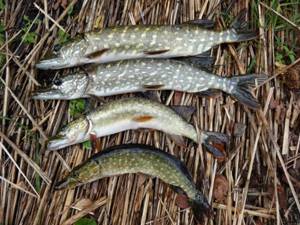
Why is there pike but not caught?
Anglers joke: “Pike is caught well all year, but not caught three times a year.”
Among the objective reasons for unsuccessful fishing are the following circumstances:
- Spawning.
- Recovery period after spawning.
- It's sunny.
Even if the law did not prohibit fishing for pike during the spawning period, it is impossible to catch it at this time. She does not react to anything other than fulfilling her main task - freeing herself from the eggs. After spawning for about fifteen days, she leaves and also refuses to bite.
On hot sunny days it is impossible to lure it out of its cool shelter at the bottom of the reservoir. The heat has a soporific effect on her. In addition, excessive lighting interferes with hunting. The time when the water warms up to 20 degrees is called “wilderness” by fishermen.
READ Croatian egg for pike - a catchy glider bait for spinning rods
Symmetrically to this, the period of winter “hibernation” is called “wilderness”. The rivers are covered with the first ice, there is a lack of oxygen, all biological processes are slowed down, and the pike is not biting.
